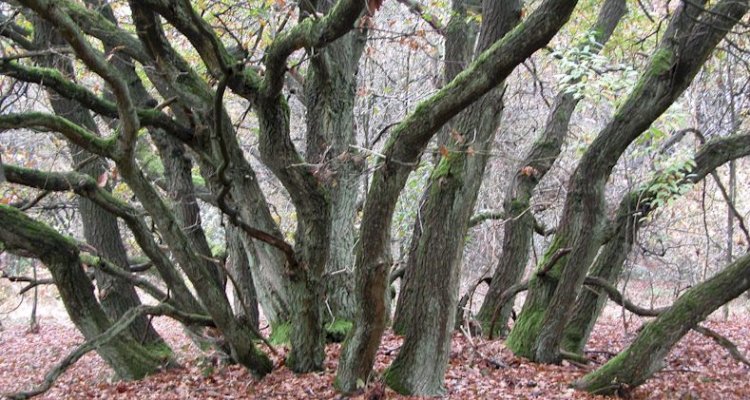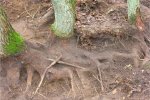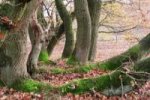
Project
The origin and age of oak clusters at the Veluwe (The Netherlands)
In 2001, the news was brought that on the Veluwe oaks were discovered of more than a thousand years old. These trees consisted of groups of stems, presumably belonging to a single genetic individual.
It was thought that these clonal groups had been formed due to a long history of coppicing. Based on the occasionally enormous size of these groups, and assuming a certain horizontal expansion rate of a coppice stool, the age of the groups was estimated up to 3000 years for the largest clones (with a circumference of 35 m).
In this project we used, amongst others, dendrochronology to study the ages and origin of these oaks. Two sites were selected at the Veluwe, one in a consolidated drift sand (Maanschoten) and the other in a heath land (Wilde Kamp). Based on tree ring measurements it turned out the oaks were much younger than previously thought. Instead of being the result of coppicing, the groups were formed due to layering of low branches. In Maanschoten (drift sand) it was caused by the harsh environment with induces shrub like growth of oak. In drift sands branches got buried easily and new adventitious roots developed. When the drift sand was reforested in the beginning of the 20th century the trees became taller and got there current shape. At the Wilde Kamp the clonal growth was caused by intensive browsing of oak shrubs in the heath lands by sheep and cattle. Browsing caused the destruction of the upper buds, leaving the lower buds unaffected. These lower buds kept producing new shoots, ultimately forming long horizontal branches close to the ground. These branches got partially buried under leaf litter and by the activity of soil organisms (such as worms and ants). On these buried branches new adventitious roots developed. The tips of the branches grew up to become trees after the sheep herds disappeared during the twentieth century. The oldest studied parts dated from 1826.
Publications
- Ouden, J. den; Copini, P.; Sass-Klaassen, U. (2009) Een nieuwe kijk op oude eiken. De Levende Natuur 110 (2). - p. 83 - 87. (PDF 491KB)
- Copini, P.; Buiteveld, J.; Ouden, J. den; Sass-Klaassen, U.G.W. (2005). Clusters of Quercus robur and Q. petraea at the Veluwe (the Netherlands) Wageningen : CGN, (CGN Report 1) - p. 45.
- Copini, P.; Buiteveld, J.; Sass, U.G.W.; Ouden, J. den (2005). DNA-analyse en leeftijdbepaling van de eikenstammen van drie eikenstrubben op de Wilde Kamp. In: Ouderdom en ontstaanswijze van cirkelvormige eikenstrubben in het natuurterrein "De Wilde Kamp" bij Garderen (Noordwest-Veluwe); tussentijds verslag van een interdisciplinair onderzoek / Spek, T., Buiteveld, J., Copini, P., Exaltus, R., Groenewoudt, B.J., Groenman-van Waateringe, W., Jong, A.G., Kregten, F. van, Maes, N.C.M., Mars, A., Ouden, J. den, Rövekamp, C.J.A., Sass-Klaassen, U.G.W., Speleers, B.P., . - Amersfoort : ROB, (Rapportage Archeologische Monumentenzorg 131) - p. 81 - 92.
- Spek, T.; Buiteveld, J.; Copini, P.; Exaltus, R.P.; Groenewoudt, B.J.; Groenman-van Waateringe, W.; Jong, A.G.; Kregten, F. van; Maes, N.C.M.; Mars, A.; Ouden, J. den; Rövekamp, C.J.A.; Sass, U.G.W.; Speleers, B.P. (2005) Ouderdom en ontstaanswijze van cirkelvormige eikenstrubben in het natuurterrein "De Wilde Kamp" bij Garderen (Noordwest-Veluwe); tussentijds verslag van een interdisciplinair onderzoek Amersfoort : ROB, (Rapportage Archeologische Monumentenzorg 131) - p. 111
MSc theses
- Copini, P. (2005). Clusters of Quercus robur and Q. petraea in the Netherlands. (supervision: den Ouden, in cooperation with Buiteveld/Alterra)
- Blomsma, M. (2009). Regenerative capacity of coppice stands of Quercus robur. (supervision: den Ouden)
- Bol, W. (2009) Unraveling past forest management of European oak (Quercus robur): determining ring-width growth patterns and axial growth. (supervision: Sass-Klaassen, Copini)
- Meer, M. van der (2010) Unraveling past forest management of European oak (Quercus robur): determining ring-width growth patterns and axial growth (supervision: Sass-Klaassen, Copini)


